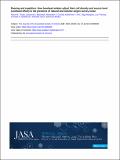Files in this item
Roaring and repetition : how bowhead whales adjust their call density and source level (Lombard effect) in the presence of natural and seismic airgun survey noise
Item metadata
| dc.contributor.author | Thode, Aaron M. | |
| dc.contributor.author | Blackwell, Susanna B. | |
| dc.contributor.author | Conrad, Alexander S. | |
| dc.contributor.author | Kim, Katherine H. | |
| dc.contributor.author | Marques, Tiago | |
| dc.contributor.author | Thomas, Len | |
| dc.contributor.author | Oedekoven, Cornelia S. | |
| dc.contributor.author | Harris, Danielle | |
| dc.contributor.author | Broker, Koen | |
| dc.date.accessioned | 2020-04-01T15:30:01Z | |
| dc.date.available | 2020-04-01T15:30:01Z | |
| dc.date.issued | 2020-03-31 | |
| dc.identifier | 267169191 | |
| dc.identifier | 293b63ce-52c3-46ba-b318-80d4f57042c2 | |
| dc.identifier | 85082879595 | |
| dc.identifier | 000522971700003 | |
| dc.identifier.citation | Thode , A M , Blackwell , S B , Conrad , A S , Kim , K H , Marques , T , Thomas , L , Oedekoven , C S , Harris , D & Broker , K 2020 , ' Roaring and repetition : how bowhead whales adjust their call density and source level (Lombard effect) in the presence of natural and seismic airgun survey noise ' , Journal of the Acoustical Society of America , vol. 147 , no. 3 , pp. 2061-2080 . https://doi.org/10.1121/10.0000935 | en |
| dc.identifier.issn | 0001-4966 | |
| dc.identifier.other | RIS: urn:19C35FF950820B4469DD6E4C1B18155A | |
| dc.identifier.other | ORCID: /0000-0002-2581-1972/work/71559570 | |
| dc.identifier.other | ORCID: /0000-0002-7436-067X/work/71559606 | |
| dc.identifier.other | ORCID: /0000-0002-5610-7814/work/71559867 | |
| dc.identifier.other | ORCID: /0000-0003-1447-1420/work/71559870 | |
| dc.identifier.uri | https://hdl.handle.net/10023/19739 | |
| dc.description.abstract | Over 500 000 automated and manual acoustic localizations, measured over seven years between 2008 and 2014, were used to examine how natural wind-driven noise and anthropogenic seismic airgun survey noise influence bowhead whale call densities (calls/km2/min) and source levels during their fall migration in the Alaskan Beaufort Sea. Noise masking effects, which confound measurements of behavioral changes, were removed using a modified point transect theory. The authors found that mean call densities generally rose with increasing continuous wind-driven noise levels. The occurrence of weak airgun pulse sounds also prompted an increase in call density equivalent to a 10–15 dB change in natural noise level, but call density then dropped substantially with increasing cumulative sound exposure level (cSEL) from received airgun pulses. At low in-band noise levels the mean source level of the acoustically-active population changed to nearly perfectly compensate for noise increases, but as noise levels increased further the mean source level failed to keep pace, reducing the population's communication space. An increase of >40 dB cSEL from seismic airgun activity led to an increase in source levels of just a few decibels. These results have implications for bowhead acoustic density estimation, and evaluations of the masking impacts of anthropogenic noise. | |
| dc.format.extent | 20 | |
| dc.format.extent | 7516296 | |
| dc.language.iso | eng | |
| dc.relation.ispartof | Journal of the Acoustical Society of America | en |
| dc.subject | QH301 Biology | en |
| dc.subject | GC Oceanography | en |
| dc.subject | 3rd-DAS | en |
| dc.subject.lcc | QH301 | en |
| dc.subject.lcc | GC | en |
| dc.title | Roaring and repetition : how bowhead whales adjust their call density and source level (Lombard effect) in the presence of natural and seismic airgun survey noise | en |
| dc.type | Journal article | en |
| dc.contributor.institution | University of St Andrews. School of Mathematics and Statistics | en |
| dc.contributor.institution | University of St Andrews. Scottish Oceans Institute | en |
| dc.contributor.institution | University of St Andrews. Centre for Research into Ecological & Environmental Modelling | en |
| dc.contributor.institution | University of St Andrews. Statistics | en |
| dc.contributor.institution | University of St Andrews. Marine Alliance for Science & Technology Scotland | en |
| dc.contributor.institution | University of St Andrews. Sea Mammal Research Unit | en |
| dc.identifier.doi | https://doi.org/10.1121/10.0000935 | |
| dc.description.status | Peer reviewed | en |
This item appears in the following Collection(s)
Items in the St Andrews Research Repository are protected by copyright, with all rights reserved, unless otherwise indicated.

